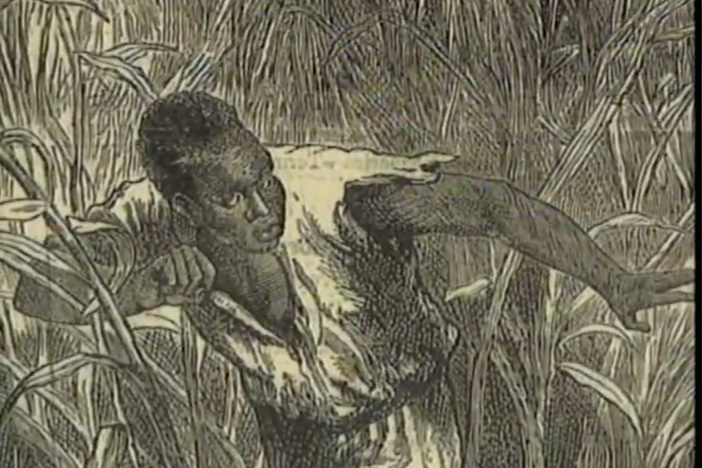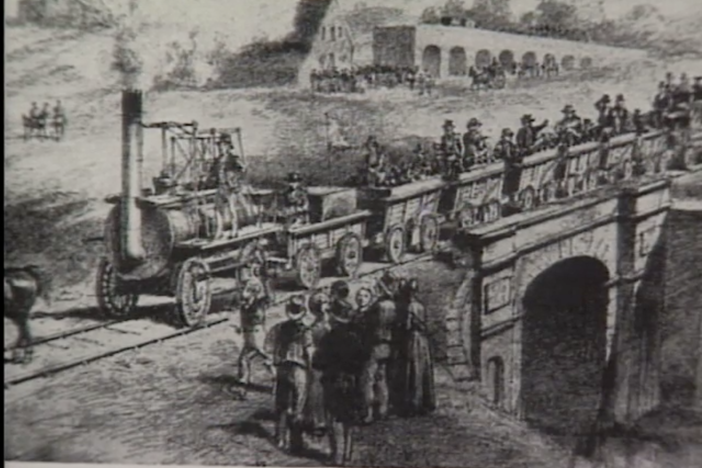Making Cotton Pay
John Johnson, Director of Interpretation and Education at the Agrirama in Tifton, explains the economic impact of going from one person able to seed one pound of cotton a day to Eli Whitney's cotton gin seeding 50 pounds of cotton a day. Dr. Jerry DeVine of Albany State College notes that the increase in cotton production saw a parallel increase in slavery. Slaves and land were the two greatest forms of wealth in Georgia, with more money invested in slaves than land.
Making Cotton Pay
John Johnson, Director of Interpretation and Education at the Agrirama in Tifton, explains the economic impact of going from one person able to seed one pound of cotton a day to Eli Whitney's cotton gin seeding 50 pounds of cotton a day. Dr. Jerry DeVine of Albany State College notes that the increase in cotton production saw a parallel increase in slavery. Slaves and land were the two greatest forms of wealth in Georgia, with more money invested in slaves than land.
Social Studies
Evaluate the economic impact of various industries in Georgia including agricultural, entertainment, manufacturing, service, and technology.
Explain how technological developments, including the cotton gin and railroads, had an impact on Georgia's growth.
1. What role did the cotton gin play in the development of the cotton economy in Georgia and the wider South?
2. How do you think increased cotton production affected the relationship between Georgians and Native Americans?
3. Although the cotton gin led to increased production and economy, it also had the unintended consequence of increasing the demand for slavery. Can you think of other innovations or inventions that had unintended negative consequences? Why?
1. This video leaves no doubt about the enormous impact of the cotton gin in Georgia. Are there other inventions that brought about similar dramatic changes in the state? Think about that and then make nominations to the “Invention Hall of Fame” giving reasons why their nominee should be included.
cotton gin: a device that separates cotton seeds from the fluff of the cotton
capital: things one possesses that go toward the manufacture of other things (money, buildings, know-how, workers, etc.)
patent: legal recognition of one's priority in developing an invention or technique granting control of the use of that invention or technique—and the monetary rewards therein—to the person holding the patent
pretensions: boastful claims about one's abilities
remuneration: to reimburse; to pay back
King Cotton: the predominance of the production and trade of cotton in the South Sea Island Cotton: long-staple cotton primarily grown on land around the marshes and islands of Georgia
Upland Cotton: most common cotton grown; has varying fiber lengths
1. What role did the cotton gin play in the development of the cotton economy in Georgia and the wider South?
Cotton production was made vastly more efficient exponentially increasing (by fifty times) the amount of cotton a person could seed in a day. The increase in cotton production saw an increase in the demand for slaves and the acreage cotton crops take up as well. Increasingly, wealth in the South became invested in land for growing cotton and the slaves that would help turn that cotton into profits.
2. How do you think increased cotton production affected the relationship between Georgians and Native Americans?
Increased cotton production and the subsequent increased demand for land in Georgia likely led to more pressure on on Native American groups to cede more of their land to Georgian settlers who were moving west.
3. Although the cotton gin led to increased production and economy, it also had the unintended consequence of increasing the demand for slavery. Can you think of other innovations or inventions that had unintended negative consequences? Why?
Answers will vary but students may mention technology like phones and televisions or even weapons like the nuclear bomb.





